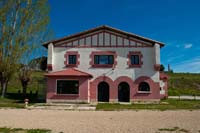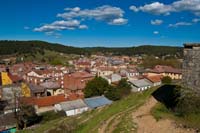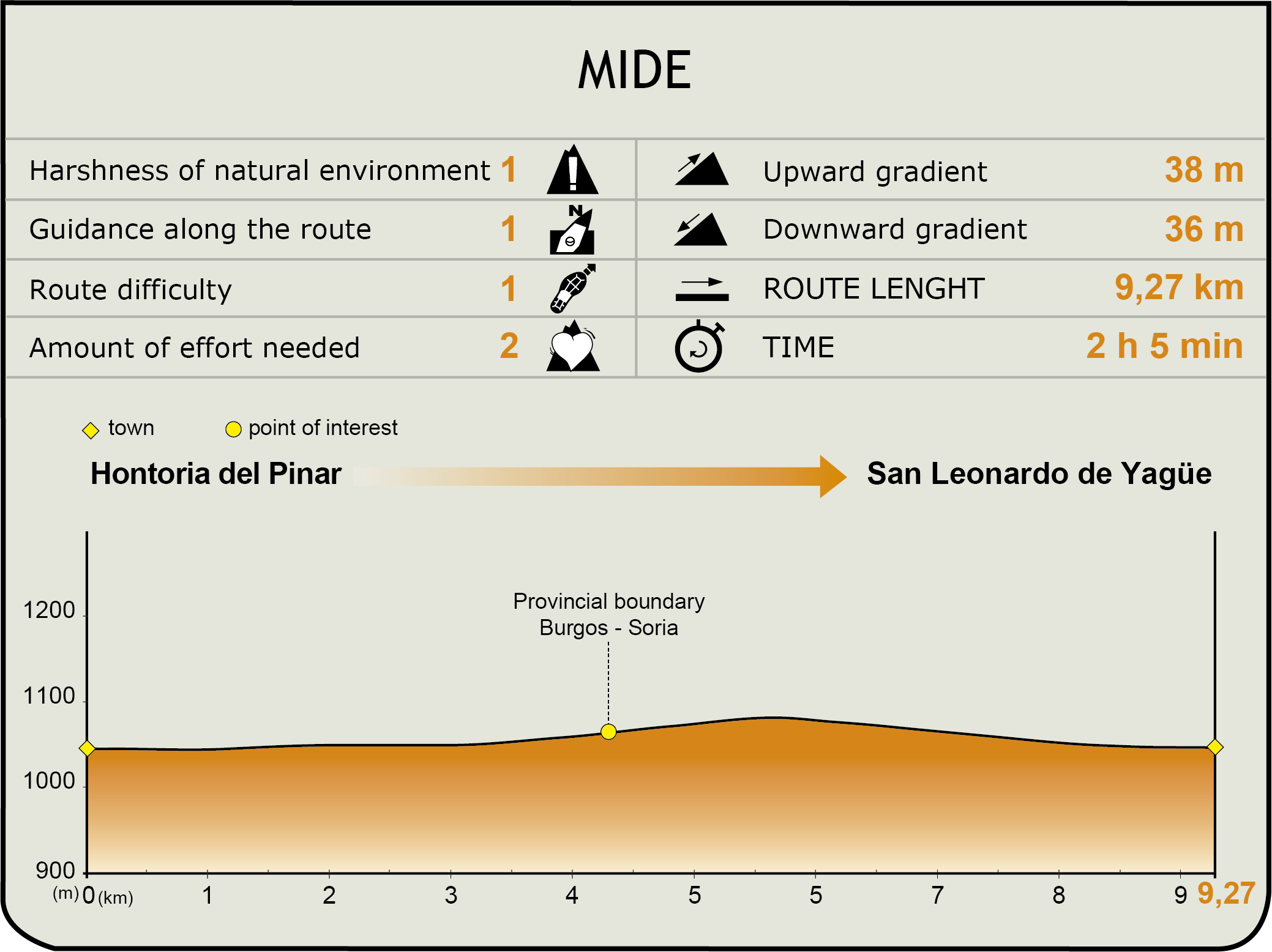- Home
- Rural Development
- Nature Trails
- Nature Trails
- Northwest Sector
- Santander-Mediterráneo
Santander Mediterráneo Nature Trail. Hontoria del Pinar - San Leonardo de Yagüe section
Description
In the past, the train covered the route between the provinces of Burgos and Soria, entering going deep into pine forests.
This small section begins in the town of Hontoria del Pinar, located next to the Lobos River and very close to its Natural Park, which downstream leads to spectacular canyons and cliffs in which the impressive griffon vulture lives. From this town in the province of Burgos, you can move on by faithfully following the old railway line until you reach San Leonardo de Yagüe, which is already in the province of Soria, after a pleasant and comfortable trip.

In the centre of the Burgos town of Hontoria del Pinar, this short section of the Santander-Mediterranean Sea Nature Trail begins which, at a little more than nine kilometres of length, joins the provinces of Burgos and Soria.
A rest area is located just before one of the accesses to the Lobos River Canyon Natural Park, which is an extraordinary environment where the griffon vultures (Gyps fulvus) fly over and nest in the beautiful cliffs cut with patience by the river’s waters.
Returning to the old railway line, you can reach the different buildings of the Hontoria del Pinar former station, where all of them are in perfect condition (except the warehouse), since nowadays they are in operation as a tourist lodge.
After a new rest area, located next to the warehouse of the station, you can move on while being able to enjoy the first foothills of the Lobos River Canyon Natural Park. The riparian vegetation of the Mayuelo and Laprima Rivers decorates this part of the trail, going past the 3rd kilometre point; several specimens of poplar (Populus sp.) and willow (Salix sp.) can be highlighted therein.
The trail runs parallel to the N-234 road while the pine forest (Pinus sylvestris) begins to become greater, highlighting the salmon colour of the upper part of its trunks that provides the route with a special beauty. After overcoming another kilometre, the aforementioned road and an old variant thereof are crossed by two operational bridges. Shortly after, the typical signalling of natural roads indicates the exact location of the traveller: the provincial limit between Burgos and Soria.

The old railway track traces a curve that is now moving in a south-easterly direction while the density of the pine forest increases. After the 6th kilometre, a forest of Pyrenean oaks (Quercus pyrenaica) breaks the hegemony of the Scots pine. This is a widespread species of key importance in the province of Soria, where a large part of its economy has been based on the wood of this high-quality pine, which is mainly used in construction.
The trail leaves on its right a small industrial area, which precedes the first homes of San Leonardo de Yagüe. The trail continues with the town centre remaining on the right of the route. Then, shortly after reaching the 9th kilometre, you will arrive at the former station of San Leonardo de Yagüe, which brings this section of the Santander-Mediterranean Sea Nature Trail to an end. In this way, the municipalities of Hontoria del Pinar and San Leonardo de Yagüe are thus connected and, accordingly, the provinces of Burgos and Soria.
Map
Puntos de Interés
Hidrografía
Profile

Featured
Further information
Hontoria del Pinar
Hontoria del Pinar is located in the heart of the Sierra de la Demanda mountains, about 80 km away from the capital, Burgos. The origins of the settlement that gave rise to this town date back to the Neolithic Era and the Iron Age; however, the consolidation of the municipality as it is known today would not come until the 10th century, when these lands were repopulated after the expulsion of Muslims.
In this municipality, patrimonial elements must be noted such as the medieval bridge over the Lobos River, built in Romanesque style over three eyes to cross the riverbed and over which the Roman road that linked the Roman cities of Clunia and Uxama passed. Other buildings feature such as the parish church of the town.
In this natural environment, the Lobos River Canyon, which is an enclave of great beauty and environmental and scenic richness, is also noteworthy.
With regard to its festivities, this municipality of Burgos holds its festivities in honour of Our Lady and San Roque from 14 to 17 August.
San Leonardo de Yagüe
This is a town in Castilla and Leon in the north east of the province of Soria. It has been inhabited since prehistoric times, as proven by to the settlements in various caves in the Cañón del Río Lobos canyon. Celtic settlements built different forts in the area, and after Roman times the town of San Leonardo was definitively established around a hospital of pilgrims. It is a town with a definite forestry nature, and to this day a good amount of its economy is based on this. In terms of the architectural heritage, highlights include the bastioned castle of Juan Manrique de Lara, a 16th century Renaissance building, the San Leonardo Abad church and the medieval arch of the Puerta de Aranda gateway, the only vestige to the medieval wall that protected the town in the past. The festivities of San Leonardo, the town's patron saint, are held on 6 November. On 22 July the Santa María Magdalena festivities take place. And the eleven religious-warrior paloteo dances take place on 2 and 3 February for the Las Candelas and San Blas festivities.
Cañón del río Lobos (River Lobos Canyon)
The Cañón del río Lobos Natural Park is a natural enclave that measures about 10,000 hectares spread between the provinces of Burgos and Soria.
It is a spectacular place cut into the limestone rocks of the environment over the years by the waters of the Lobos River, which meander throughout this landscape.
The park is a space of great environmental value where it is possible to find large colonies of griffon vultures. You can penetrate deep into this spectacular environment thanks to the numerous hiking routes that cross this space and allow you to follow the steps of the Lobos River through this landscape of unique beauty. The Bridge of the Seven Eyes is one of the main accesses to this natural enclave that crosses the river, and there is a recreational area next to it.
Likewise, without leaving the canyon of the Lobos River, you can visit the San Bartolomé Chapel, one of the main points of interest of this natural area. The extraordinary location of this temple, surrounded by pools full of water lilies and dragonflies, provides an idyllic picture in the middle of the wild nature. The chapel, built in the XII century in Romanesque style, gathers the neighbours of the area together every 24 August for the celebration of the chapel’s pilgrimage. In addition, next to the chapel, the Caves of San Bartolomé must be highlighted, which consist of two caves (Major and Minor) close to each other with different rock engravings inside. Within this protected natural area (PNA) other caves can be found, such as the Cueva Conejas (Rabbit Cave), La Galiana (Transhumance Cave) and Cueva Negra (Black Cave).